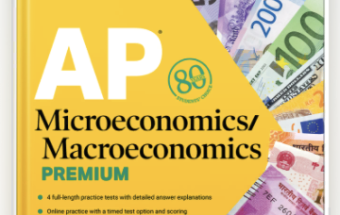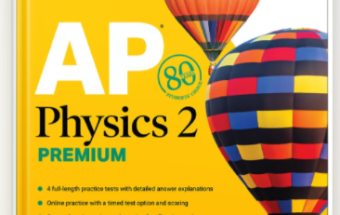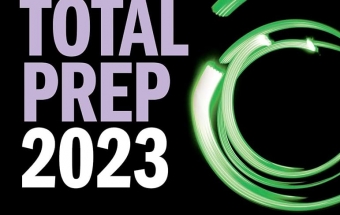AP Physics 2 Premium, 2024 - Practice Test 2
SECTION I: MULTIPLE-CHOICE
1. In a photoelectric effect experiment, increasing the intensity of the incident electromagnetic radiation will
(A) increase only the number of emitted electrons
(B) have no effect on any aspect of the experiment
(C) increase the maximum kinetic energy of the emitted electrons
(D) increase the stopping potential of the experiment
2. In a vacuum, all photons have the same
(A) frequency
(B) wavelength
(C) velocity
(D) amplitude
3. Which of the following photons has the largest momentum?
(A) X ray
(B) Ultraviolet
(C) Infrared
(D) None of these has momentum.
4. Which element will not release energy via either fusion or fission?
(A) Hydrogen
(B) Iron
(C) Helium
(D) Neon
5. Photons can scatter electrons, and the trajectories of the electrons will obey the law of conservation of momentum. These facts are observed in the
(A) Rutherford scattering experiment
(B) Michelson-Morley experiment
(C) Compton effect
(D) Doppler effect
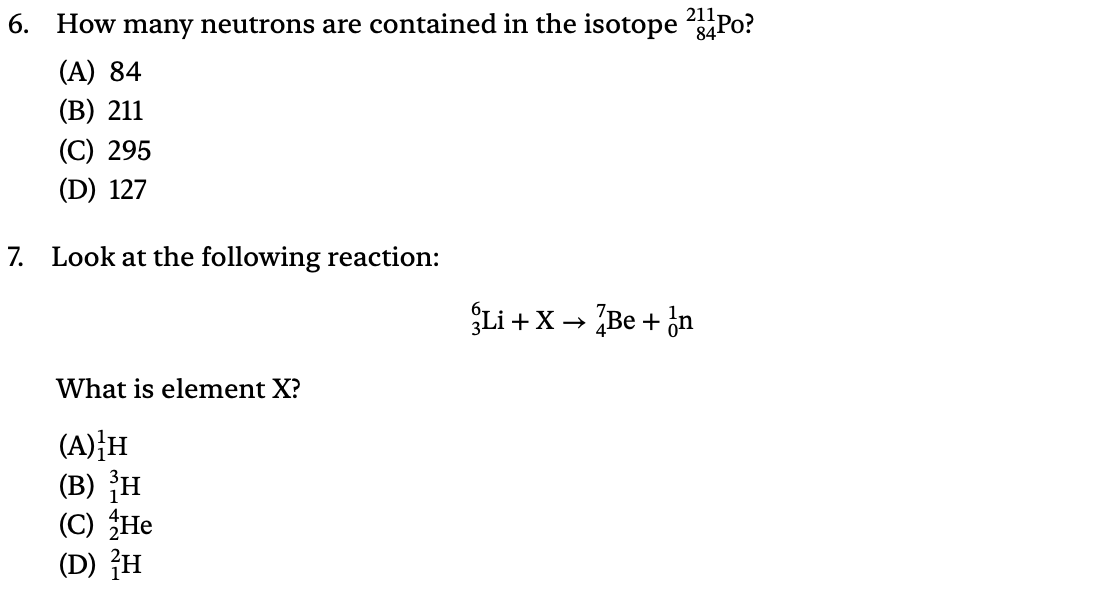
8. As hydrogen is fused into helium, the stability of the new nuclei, compared with that of hydrogen, will
(A) be greater because of greater binding energy per nucleon
(B) be less because of greater binding energy per nucleon
(C) be greater because of smaller binding energy per nucleon
(D) be less because of smaller binding energy per nucleon
9. Which of the following particles is not deflected by an electromagnetic field?
(A) Neutron
(B) Proton
(C) Positron
(D) Alpha particle
10. A ray of light is incident from a slower medium (smaller than the critical angle) to one that is faster. The refracted ray will
(A) not refract at all
(B) refract toward the normal
(C) refract away from the normal
(D) "refract” at 90 degrees such that it does not actually enter the faster medium
11. As a large object (such as a 3,000-kg car) accelerates, what is the trend in its de Broglie wavelength?
(A) Its de Broglie wavelength gets smaller.
(B) Its de Broglie wavelength gets bigger.
(C) Its de Broglie wavelength remains the same.
(D) Any object with rest mass would have to go faster than the speed of light to have a measureable de Broglie wavelength.
12. Which of the following expressions has the same SI units as PV?
(A) mv
(B) mc2
(C) Q/T
(D) gh
13. Heat conduction through a slab of a certain material depends on all of the following EXCEPT
(A) area
(B) temperature difference between the face of the materials
(C) thickness of the material
(D) specific heat capacity of the material
QUESTIONS 14–16 ARE BASED ON THE FOLLOWING INFORMATION:
An RC circuit is wired such that a 10-μF capacitor is connected in series with a 5-Ω resistor and a 6-V battery.
14. What will be the total charge that flows into one side of the capacitor?
(A) 50 C
(B) 2 C
(C) 6 × 10−5 C
(D) 5 × 10−4 C
15. Which of the following graphs best represents the increase of charge in the capacitor while attached to a constant voltage source?
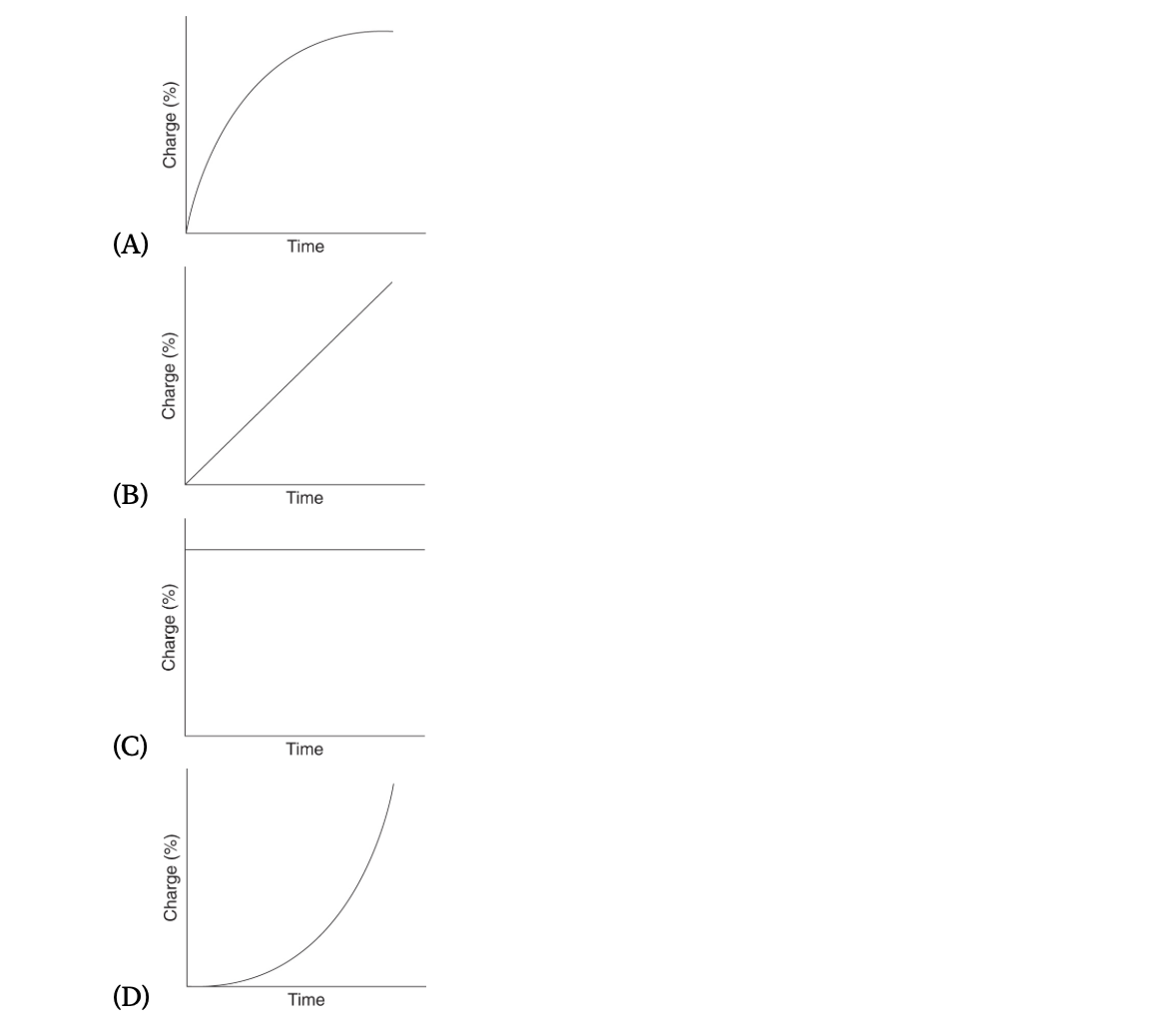
16. What is the value of the total energy stored in the capacitor?
(A) 1.8 × 10−4 J
(B) 6 × 10−5 J
(C) 3 × 10−5 J
(D) 2 × 10−5 J
17. Anti-reflecting coatings on objects are often made to be one-fourth of a wavelength thick. These coatings reduce some reflected intensities primarily because of
(A) reflection and refraction
(B) reflection and interference
(C) reflection and polarization
(D) dispersion and refraction
18. The time between maximum electric field strength magnitudes at a fixed location in a vacuum as an electromagnetic wave with a wavelength of 6 meters passes by is
(A) 5 × 107 s
(B) 2 × 10−8 s
(C) 1 × 10−8 s
(D) 2.5 × 10−7 s
19. What is the buoyant force experienced by a 10-kg cylinder with a volume of 2 × 10−2 m3 that is completely submerged in water (density ρ = 1,000 kg/m3)?
(A) 200 N
(B) 2,000 N
(C) 20 N
(D) 100 N
QUESTIONS 20–24 REFER TO THE FOLLOWING INFORMATION:
Light with a wavelength of 5.4 × 10−7 meters falls on two slits that are separated by a distance of 1.0 × 10−3 meters. An interference pattern forms on a screen 2 meters away.
20. What is the energy of each photon of this light?
(A) 3 × 108 J
(B) 4 × 10−8 J
(C) 3 × 10−33 J
(D) 4 × 10−19 J
21. What is the approximate distance between the central bright band and the next bright band?
(A) 2 m
(B) 1.08 × 10−3 m
(C) 2.7 × 10−3 m
(D) 3.6 × 10−2 m
22. The dark and bright interference pattern observed on the screen is caused by
(A) reflection and refraction
(B) refraction and diffraction
(C) polarization and interference
(D) diffraction and interference
23. If the distance between the slits and the screen is increased, the pattern spacing will
(A) increase
(B) decrease
(C) increase and then decrease
(D) remain the same
24. If light with a shorter wavelength is used in an experiment, the pattern separation will
(A) increase
(B) decrease
(C) increase and then decrease
(D) remain the same
25. As light enters a slower medium (index of refraction N2) from a faster one (index of refraction N1), its wavelength is observed to be cut down to 1/3 of its previous value. What is the ratio of N2/N1?
(A) 1.0
(B) 3.0
(C) 0.33
(D) The frequency and/or wavelength must be specified.
26. What is the critical angle for light within a transparent material (N = 2.0) when immersed in water (N = 1.3)?
(A) 30°
(B) 60°
(C) 41°
(D) No critical angle in this situation
27.A doubly ionized helium atom is accelerated by a potential difference of 400 V. The maximum kinetic energy of the ion is equal to
(A) 400 eV
(B) 200 eV
(C) 1,600 eV
(D) 800 eV
28. A neutral body is rubbed and becomes positively charged by
(A) gaining protons
(B) losing electrons
(C) gaining electrons
(D) losing protons
29. If an ideal fluid (density ρ) traveling down a horizontal pipe at a speed v1 enters a new pipe of ½ the radius, its pressure will change by
(A) 2ρv12
(B) 4ρv12
(C) 7.5ρv12
(D) 16ρv12
30. Lenz’s law is an electrical restatement of which conservation law?
(A) Linear momentum
(B) Angular momentum
(C) Charge
(D) Energy
31. A single electron traveling 2 cm away from a wire of current (2 amps) along a parallel trajectory to the wire’s current will experience a force
(A) of 0 N since the wire has no net charge
(B) directed radially away from the wire
(C) directed radially toward the wire
(D) parallel to the wire
32. An electron is moving perpendicularly through a pair of crossed electric and magnetic fields (with magnitudes E and B, respectively) with constant velocity. The fields are perpendicular to each other. Which expression represents the speed of the electron?
(A) EB
(B) 2EB
(C) E/B
(D) B/E
33. Photons with energy of 8 eV are incident on a metal surface that emits electrons in a photoelectric effect experiment. If the emitted electrons can be (A) 13 eV
(B) 8 eV
(C) 5 eV
(D) 3 eV
34. An object is placed 15 centimeters in front of a concave spherical mirror whose radius of curvature is 12 centimeters. Which statement is correct about the image formed?
(A) The image will be larger than the object and virtual.
(B) The image will be smaller than the object and virtual.
(C) The image will be larger than the object and real.
(D) The image will be smaller than the object and real.

36. Energy from the Sun is generated by
(A) the fusion of helium into hydrogen
(B) the fusion of hydrogen into helium
(C) the fission of uranium
(D) the fission of helium into hydrogen
37. If a permanent magnet is cut in half halfway between its north and south poles, you will then have
(A) a north pole piece strongly attracted to the south pole piece
(B) two pieces of magnetic material with no overall poles
(C) two smaller magnets, each with its own north and south poles
(D) a north pole piece slightly positive and a south pole piece slightly negative


39. The voltage between the plates of a fully charged parallel plate capacitor will
(A) be constant throughout
(B) fall linearly as you move from the positive plate to the negative plate
(C) fall quadratically as you move from the positive plate to the negative plate
(D) fall exponentially as you move from the positive plate to the negative plate
40. What does the electric field resemble if the field is a far distance outside of a fully charged 5-F capacitor that is charged by a 12-V battery?
(A) The electric field will resemble that of a 60-C point charge.
(B) The electric field will be uniform and directed toward the capacitor.
(C) The electric field will be uniform and directed away from the capacitor.
(D) There will be no measurable electric field due to the capacitor.
41. An electron is observed to be moving in a clockwise circular path when viewed from above. Which statement best describes the magnetic field causing this?
(A) The magnetic field is directed upward.
(B) The magnetic field is directed downward.
(C) The magnetic field is directed radially in the place of the circular path.
(D) No magnetic field is prensent.
42. A perpetual motion machine is an object with moving internal parts that never stop moving. Which concept best explains why an isolated perpetual motion machine is not possible?
(A) Conservation of energy
(B) Thermal conductivity
(C) Increase of entropy
(D) Conservation of momentum
43. One mole of helium is compared with one mole of nitrogen gas. Both gases are at the same temperature and pressure. Which statement is true?
(A) The helium gas takes up less volume than the nitrogen gas because helium is a lighter molecule.
(B) The helium gas molecules are moving faster on average than the nitrogen molecules because helium is a lighter molecule.
(C) The speed of sound through the nitrogen gas will be faster since the nitrogen molecule is heavier.
(D) The force delivered per area by the bouncing molecules of helium will be smaller than that from the nitrogen molecules since helium is a lighter molecule.
44. The fact that two oncoming headlights of a car cannot be resolved at large distances (i.e., the two light sources are seen as one) is best described by
(A) wave interference
(B) refraction
(C) dispersion
(D) diffraction
45. The Sun’s light strikes the ground and heats it, which in turn heats the air in contact with the ground. This warm air rises and allows cooler air to rush in. What is the sequence of thermal energy transfer events?
(A) Convection → conduction → convection
(B) Radiation → conduction → convection
(C) Radiation → convection → conduction
(D) Conduction → conduction → convection
46. Which of the following are true about a fully charged capacitor in a circuit? Select two answers.
(A) It has a net charge of zero.
(B) It effectively allows current to pass through it.
(C) It has a voltage difference of zero across it.
(D) It can act as an emf source.
47. If small, plastic ball X attracts a similar ball Y but repels a third ball Z, which of the following are true? Select two answers.
(A) Y may be oppositely charged from Z.
(B) Z may be neutral.
(C) Y may be neutral.
(D) X may be neutral.
48. An electron traveling in a northward direction is momentarily deflected upward. What can accomplish this? Select two answers.
(A) A downward electric field
(B) A westward magnetic field
(C) An upward electric field
(D) An eastward magnetic field
49. A resistor and a capacitor are in parallel with each other and embedded in a larger circuit. Initially, there is current running through the resistor only; there is an open switch next to the uncharged capacitor. Then the switch is closed, allowing the capacitor to charge. Consider the resistor from before the switch was closed and after the capacitor is allowed to fully charge. Which of the following statements are true? Select two answers.
(A) The current going through the resistor is the same.
(B) The voltage drop across the resistor is the same.
(C) The current through the resistor has dropped significantly.
(D) The voltage drop across the resistor has dropped significantly.
50. A solid, uncharged conducting sphere is placed within a strong external electric field. Which of the following statements are true? Select two answers.
(A) A surface charge will be induced on the sphere.
(B) The electric field within the sphere will be zero.
(C) The external electric field away from the sphere will be significantly altered by the presence of the sphere.
(D) The sphere will be induced to have a net charge.
SECTION II: FREE-RESPONS
1. (10 points; ~20 minutes) A group of students are given two resistors (100 ohm and 200 ohm), a single capacitor (15 mF), two switches, 2 voltmeters, 2 ammeters, a 12-volt battery, and many alligator clip–style wires that can be used to connect these elements. The students are instructed to use these elements to determine the effect of adding a capacitor in parallel to an existing simple circuit.
(a) Describe how these elements could be set up to monitor the voltage across both resistors and the current through them. The capacitor along with one of the resistors should be controlled by a switch such that they can be part of the circuit or not as the switch is opened or closed. The second resistor should be in parallel with the capacitor-resistor combination. You should include a labeled circuit diagram of your setup to help in your description.
(b) Indicate what procedure to follow with your circuit design in order to determine the voltage and current of both resistors with and without the capacitor in the circuit. Include enough detail so that another student could carry out your procedure.
(c) Based on the given values and assuming ideal conditions, predict the results of your procedure in part (b). Give numerical predictions for steady-state behaviors. Give a qualitative description of any changes over time that you expect to see.
(d) Describe what effect the internal resistance of the battery might have on the students’ actual results in part (c). Additionally, explain and describe the effects that any resistance within the ammeters themselves might have on the students’ results.
(e) Describe qualitatively what would happen to the reading on both voltmeters and ammeters if, after the capacitor is fully charged, the battery is suddenly removed from the circuit, leaving an open circuit in its place.
2. (12 points; ~25 minutes) A ray of light is incident on an unknown transparent substance from the air. The angle of incidence is 40°, and the angle of refraction is 22°.
(a) Explain why these measurements indicate that a change in speed must be happening as the light changes medium. Qualitatively justify whether the speed of light in the unknown transparent substance is higher or lower than that of air.
(b) Calculate the absolute index of refraction for this substance. Calculate the velocity of light in this substance.
(c) The substance is now submerged in glycerol (N = 1.47). Calculate the critical angle of incidence for light going from the unknown substance into glycerol. Explain why there is no critical angle when going the other way, from glycerol into the substance.
(d) The substance is now shaped into a convex lens. How does the focal length of this lens compare with the focal length of a similar-shaped lens made out of crown glass (N = 1.52)? Justify your answer.
3. (12 points; ~25 minutes) A student is investigating an unknown radioactive source with a Geiger counter. The Geiger counter clicks when it detects ionizing radiation but does not distinguish between alpha, beta, and gamma particles. The number of clicks indicates the number of ionizing events happening in the Geiger counter device due to the radiation it receives. The student puts a piece of paper between the radioactive source and the Geiger counter and does not notice a change in the clicking rate. However, the addition of one sheet of aluminum foil does decrease the rate. When several sheets of aluminum foil are layered in a thickness of about a centimeter, there are no clicks at all.
(a) What type of radiation is being emitted? Justify your choice by describing alpha, beta, and gamma particles and how they interact with matter.
(b) What is happening to the atomic number and mass number within each atom that emits this radiation? Is it possible to predict which radioactive atoms within the sample will be emitting the radiation next?
(c) Is the binding energy per nucleon within the radioactive atoms changing as the radiation is being emitted? If so, is the binding energy per nucleon going up or down? Justify your answer with a qualitative explanation.
(d) If the half-life of the radioactive material being investigated is twelve hours, what will happen to the click rate of the Geiger counter after three days?
4. (10 points; ~20 minutes) A single electron in an excited energy state transitions down to a lower energy state within an atom. A photon is emitted.
(a)Which of the following about the photon is uniquely fixed by the electron’s transition? Justify your answer.
____Speed
____Wavelength
____Frequency
(b) Does the relativistic mass of this atom increase, decrease, or remain the same during this action? Justify your response qualitatively, using equations as necessary.
(c) Imagine that the emitted photon is eventually absorbed in deep space by a different electron. This absorbing electron is heading straight toward the emitted photon at a speed of 0.5 c, where c is the speed of light.
i.From the absorbing electron’s point of view, what will be the speed of the emitted photon?
ii.After absorption, will the electron speed up, slow down, or continue at the same speed?
Justify your answers.


